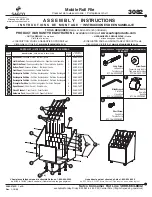
Assembly Safety
□ Wear proper attire when assembling disk. Always wear relatively tight and belted clothing to
avoid entanglement in equipment. Wear sturdy, grip work shoes and protective equipment for
eyes, hands, hearing and head.
□ Handle the disk gang components with care during assembly. The disk blades are sharp and can
cut hands, feet, etc.
□ Disk blade assemblies and disk weldments and components are heavy and awkward. Two-
person assembly is recommended. When working with others, try to maintain visual contact and
communicate actions and procedures which may present a danger to them.
□ Read assembly instructions thoroughly before beginning.
□ Use the proper tools and equipment for assembly. Make sure you understand the safe
procedures for the motorized equipment and lifting devices you will be using. Make sure tools
and equipment are in good repair.
□ Use proper supports for the job and chock tires or any other components that could roll
inadvertently.
□ Purge air from hydraulic systems before operation. After connecting the hydraulic lines, carefully
cycle the hydraulic cylinder several times to purge air from the system. Visually check all
connections for leaks.
□ Never use your hands to check for hydraulic leaks.
Assemble the Disk
□ The disk is normally shipped with the bridle and transport assemblies attached to the frame. The
gang assembles are bolted to the gang bars and the scrapers are bolted to the scraper bars. The
hitch, side arm, levelling control assemblies, transports control assemblies, jack and hose holder
are bundled together. Tires are shipped loose and the remaining components (hydraulics,
lighting, etc) are usually crated.
□ The parts diagrams in this manual may facilitate assembly of the disk.
□ These instructions require a forklift, boomlift or similar type of equipment which is capable of lifting
the disk weldments. A minimum 8000 lb outdoor application forklift with fork extensions is a good
choice. A tractor to move the disk and charge and operate the hydraulic cylinder will also be
required.
□ The following tools will also be required:
1. A selection of chains and straps.
2. Box end wrench set to 1-1/4” plus 1-1/2” and 1-7/8”.
3. Socket and rachet sets to 1-1/4” plus 1-1/2” and 1-7/8”.
4. Hammers and sledge hammer.
5. Pinch bar.
6. 24” adjustable wrench.
7. Pliers and vise grips.
8. ½” and ¾” drive air wrench and sockets.
24
















































